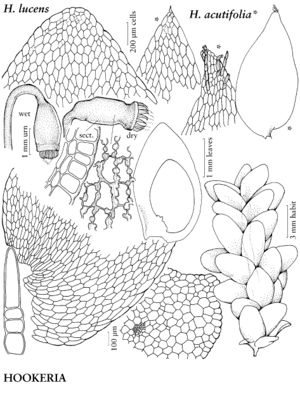Plants medium-sized to large, in creeping mats or patches. Stems green, loosely complanate-foliate; hyalodermis and sclerodermis absent, central strand present. Leaves broad, dorsal leaves often broader, more symmetric than lateral leaves; margins plane, entire, unbordered; apex rounded-obtuse to sharply or broadly acute, flat; ecostate; laminal cells large, lax, smooth, uniform across insertion and base or somewhat shorter than medial. Specialized asexual reproduction by filaments among apical leaf rhizoids, filaments unbranched, 1-seriate, subpapillose. Sexual condition autoicous or sometimes dioicous; perigonia on stem, gemmate. Seta red to reddish or blackish, elongate, smooth. Capsule suberect to pendulous, smooth; exothecial cells strongly collenchymatous; annulus distinct; peristome dark red, diplolepidous; exostome unfurrowed, with zigzag median line; endostome basal membrane high, segments extending barely beyond exostome teeth, ± perforate, cilia rudimentary or absent. Calyptra somewhat lobed at base, multistratose at middle, smooth, naked.
Distribution
Nearly worldwide, tropical and temperate regions.
Discussion
Genera 2, species ca. 8 (1 genus, 2 species in the flora).
Hookeriaceae, once consisting of many genera (W. H. Welch 1966, 1976), is currently recognized as comprising two genera (B. Goffinet et al. 2008; W. Frey 2009+): Crossomitrium Müller Hal., with six species (B. H. Allen 1990), and Hookeria with ten species, only two of which are well known (M. R. Crosby et al., unpubl.). The absolute absence of a costa in the leaves is a major character separating this family from those closely related.
The two species of Hookeria in the flora area have laminal cells large enough to observe with a hand lens, lax and broadly oblong-hexagonal or rhomboidal. Lepidopilum (Bridel) Bridel, as L. polytrichoides (Hedwig) Bridel, previously recognized in Hookeriaceae but now in Pilotrichaceae, has been reported by W. H. Welch (1962) and W. D. Reese (1984) from a single collection near Pensacola, Florida. This species has not been found in that area, despite extensive sampling. Reese suggested that it was collected elsewhere and mislabeled.
